Groningen walking tour
Groningen is the perfect place for an off-the-beaten-track weekend escape. Home to a world-class university, its young population makes it dynamic and hip, yet its small size keeps it friendly and relaxed. This walking tour of Groningen center could last from two hours, if you just stroll, to all day, if you take your time and stop to see everything. Locations are shown on the map at the bottom of this article!
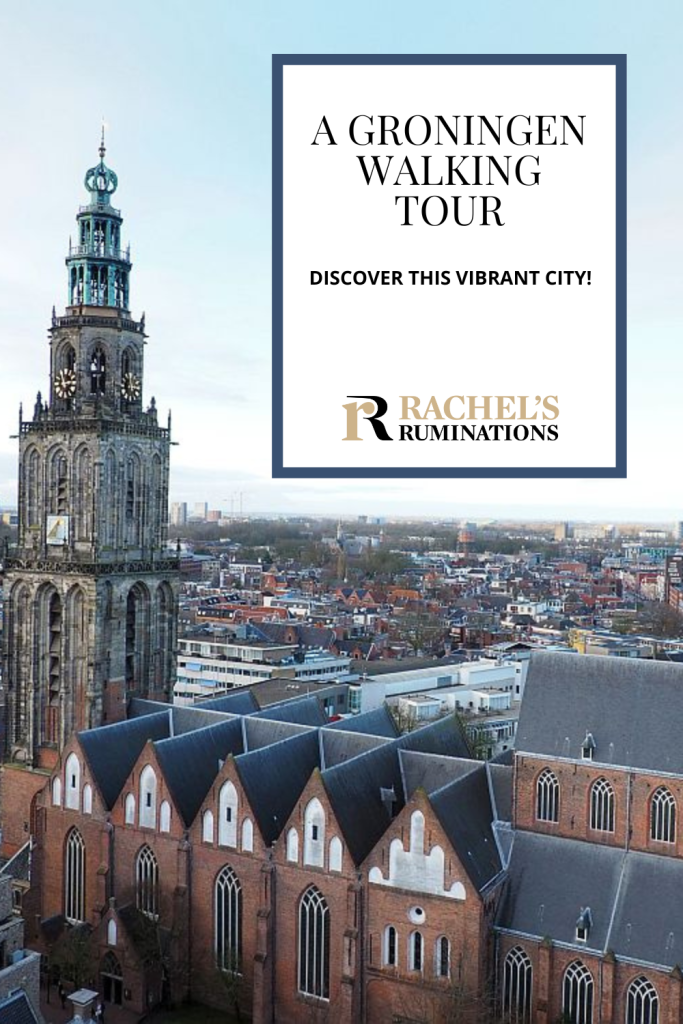
Note: This article contains affiliate links. If you click on one and spend money, I will receive a small commission. This will not affect your costs.
A. Groningen train station
Start your walk at the train station (A on the map below), but don’t hurry away yet. Go into the main hall and admire the renovated original ceiling from 1896. This station is generally acknowledged to be the prettiest in the Netherlands. The Starbucks, inside what used to be the first-class lounge, is quite special too!
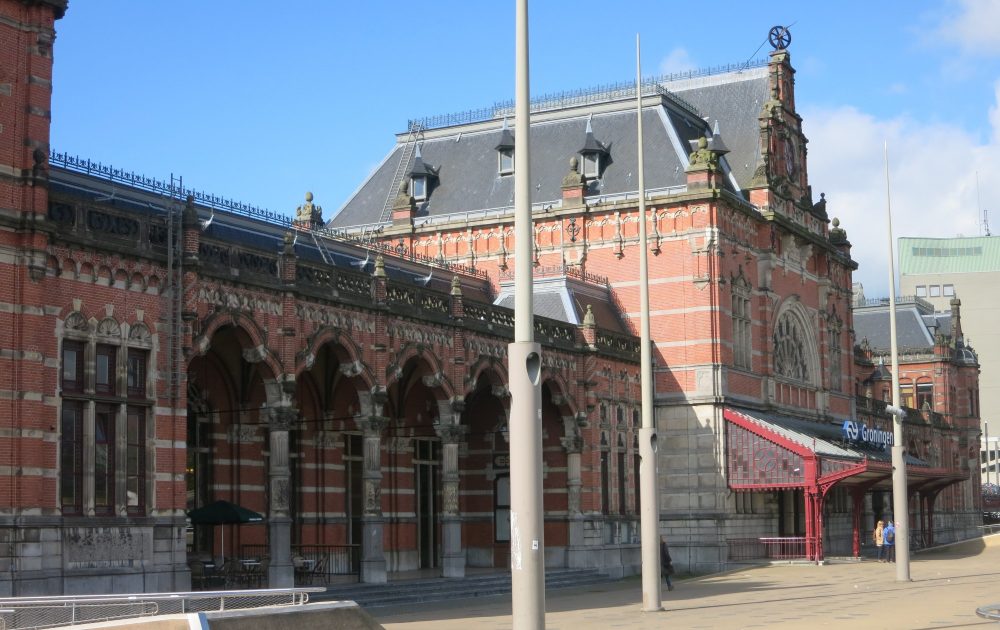
B. The Groninger Museum
Do you prefer hip and modern? Cross the street to take in the small-scale but nevertheless cutting-edge Groninger Museum (B). The post-modern building itself, designed by Alessandro Mendini, Philippe Starck and Michele de Lucchi, among others, is surprising, and worth a look both inside and out. The permanent collection and temporary shows are varied and often groundbreaking.
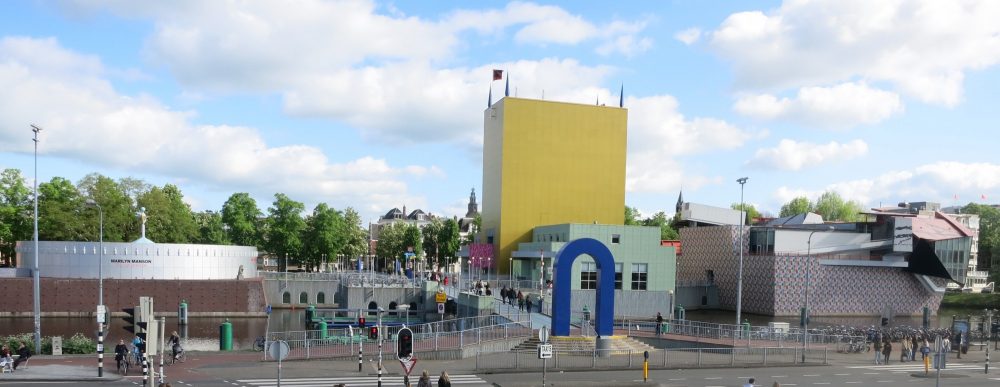
C. The Folkingestraat
Follow your dose of the post-modern with a stroll toward the center of town along the Folkingestraat, a street that combines a bit of everything. This was once the Jewish quarter of the city, and you’ll pass the historic synagogue(C) on the right, now used as both a place of worship and an exhibition space.
For contrast, look down the streets to the left and right just past the synagogue to glimpse Groningen’s very own red light district. Further along, the Folkingestraat brims with some of the best shopping in town: no chain stores here! Small boutiques selling everything from antiques and art to musical instruments and kitsch can keep you busy for hours. Watch out for bicycles: it can get pretty crazy on this street!
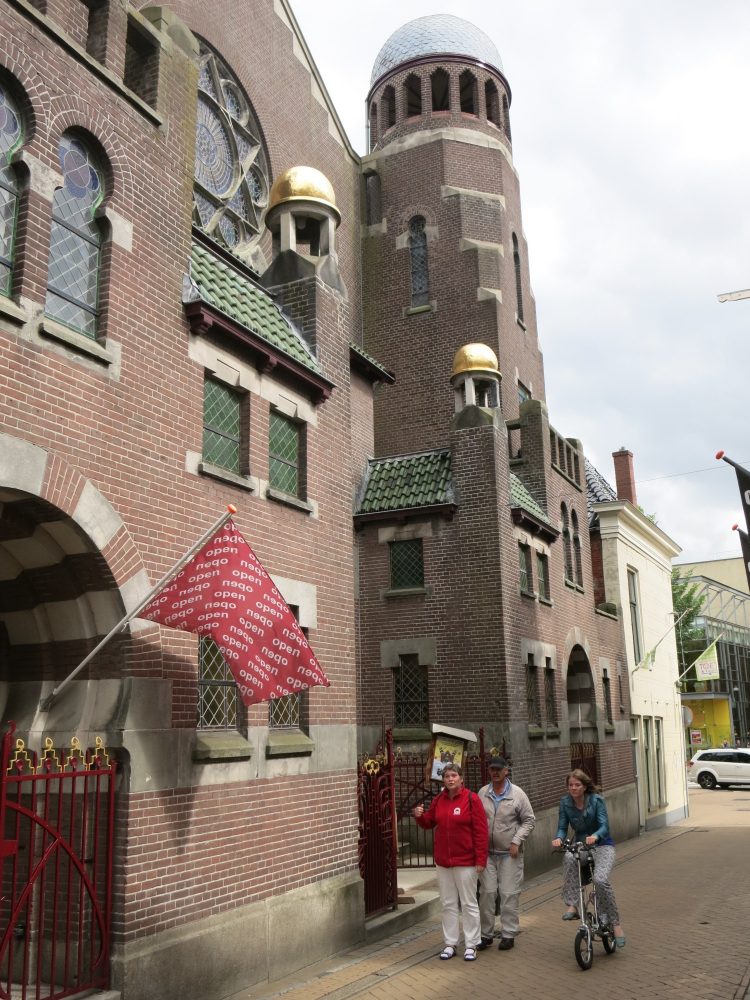
If you look carefully, you’ll see indications of the Jewish community that used to live and work on this street. See if you can find the remaining tiled picture of a cow on the doorway of what was once a kosher butcher. Also watch for “stumble stones” showing where Jews used to live who were later sent to the extermination camps.
D. Aduardergasthuis
If you’d like, take a side street to the left, over to Aduardergasthuis (D) on Munnekeholm, an almshouse dating from 1604. If the door’s open, go ahead and peek inside. A dozen or so of these historic almshouses scattered around the center of town continue to provide housing, though they’re no longer for the poor. Each tiny house faces on an inner, shared garden, a peaceful haven for the residents.
Read about lots more to see in Groningen and Groningen province in this article!
E. Huis de Beurs
Rest your tired feet in one of the many cafés. The Huis de Beurs (E), on the corner of the Folkingestraat and the Vismarkt, is a traditional “brown café” since 1795: there are no carpets on the tables anymore, but the atmosphere remains. Order a coffee or a Jenever, a locally-distilled liquor, and settle in for some great people-watching.

F and G. The A-Kerk and Museum aan de A
Next, stroll past the A-Kerk (A-Church)(F) and along Brugstraat to the Museum aan de A (G)—the oldest building in town, where you can learn all about the history of the city and province of Groningen, as well as about Groningen’s maritime history from when it was a member of the Hanseatic League.
The A, by the way, refers to the A River (pronounced “ah”), the river that runs through the city. In cities all over the Netherlands, water control efforts have altered rivers over the centuries to allow shipping and prevent flooding. In other words, you can’t tell rivers from canals unless you’re outside of cities.
H. Hooge der A
Do you want typical Dutch charm? Take a right at the canal/river onto Hooge der A (H). This stretch of canal/river rivals any Amsterdam view, with its antique ships—now mostly used as houseboats—and old warehouses converted to homes.
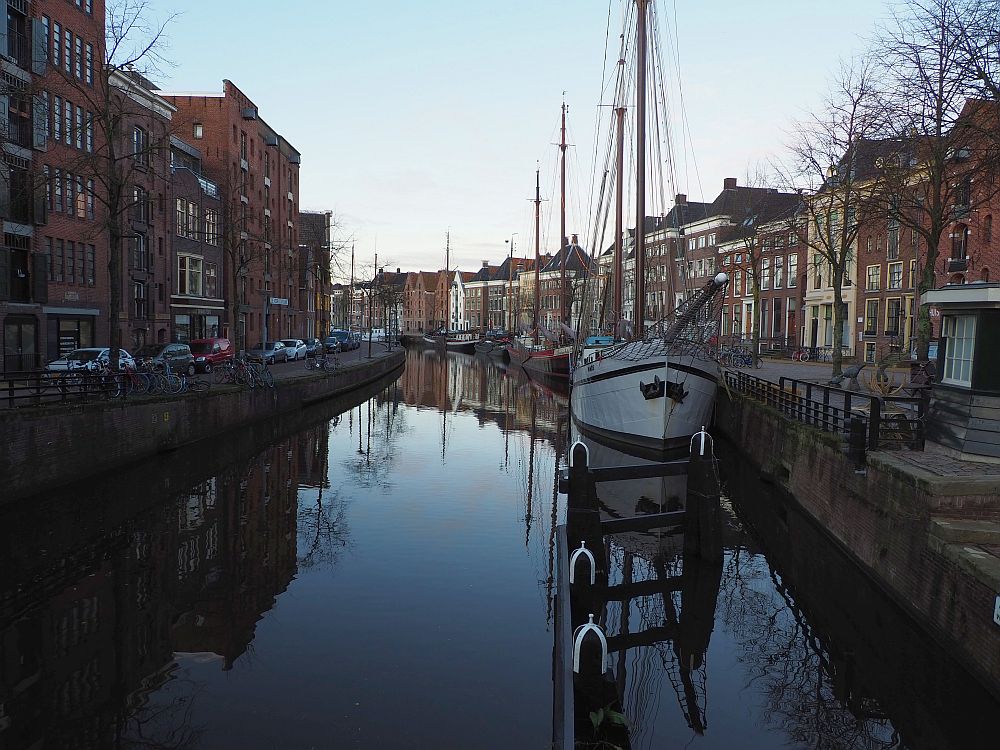
Head left at the canal instead of right, and you’ll see one of Groningen’s oddest sights on the bank of the canal/river: a public bathroom. Why is that something to see, you ask? Because it was designed by Rem Koolhaas in 1996 and the photographic artwork on the outside is by Erwin Olaf. It’s called “A Star is Born.”
I. The Vismarkt
Now double back down Brugstraat past the A-Kerk to wander among the stalls on the Vismarkt (I) (which translates as “fish market”). Here, on Tuesdays, Fridays and Saturdays, locals and students do their shopping for fresh produce and other provisions.
Book your accommodations in Groningen. Use the map function to find a hotel right in town!
At the market, don’t miss Hollandse nieuwe: raw brined herring. To look like a local, pick it up by the tail, throw your head back and eat it by hanging it over your mouth, biting off pieces from head to tail. The vendor will ask whether you want onions with it: if you say yes, they’ll give you chopped onions to dip the fish into before eating it. If raw herring is too far out for you, try kibbeling. That’s pieces of deep-fried fish, usually served with a garlic mayonnaise sauce.
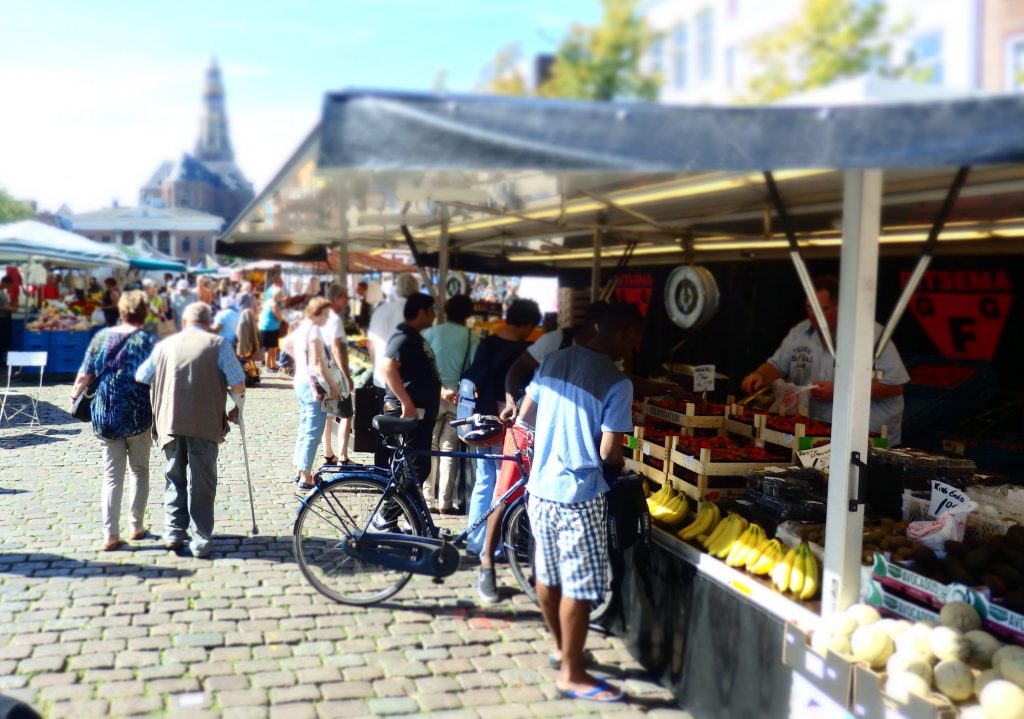
J. The Grote Markt
The market extends to the Grote Markt (J) (“big market”), just next door to the Vismarkt. Here, though, the wares include clothing, bags, shoes, and just about everything else, particularly on Saturdays. You can buy stroopwafels in a supermarket, but on the Grote Markt you can taste the wonderfully sweet, freshly-made originals while they’re warm. They’re made of two thin, sweet wafels with gooey caramel sauce sandwiched between them.
Notice as well the Drie Gezusters: a row of four centuries-old houses, with lots of tables and umbrellas out front. The pub inside is reputed to be the largest pub in all of the Netherlands. In good weather, the outdoor tables are always packed.
Before the Second World War, the Grote Markt was surrounded by pretty buildings similar to the Drie Gezusters row. Unfortunately, in the very last few days of the war, as the Allies pushed the Germans back into Germany, Groningen’s one and only battle took place. It destroyed many buildings in the center of the city.
The large building in the middle of the Grote Markt is the 19th-century Stadhuis: Groningen’s City Hall. Here’s a bit of trivia: Wednesday mornings at 9:00 or 9:30 people can get married in the Stadhuis for free.
J. The Martinitoren and the Forum
At this point, standing on the Grote Markt, you’ll see a couple of taller landmarks. One is the Martinitoren, the 600-year-old bell tower on the corner of the Grote Market. It stands, slightly leaning, at one end of the Martinikerk (St. Martin’s Church). The Martinikerk operates as a church on Sundays but otherwise as an event hall.
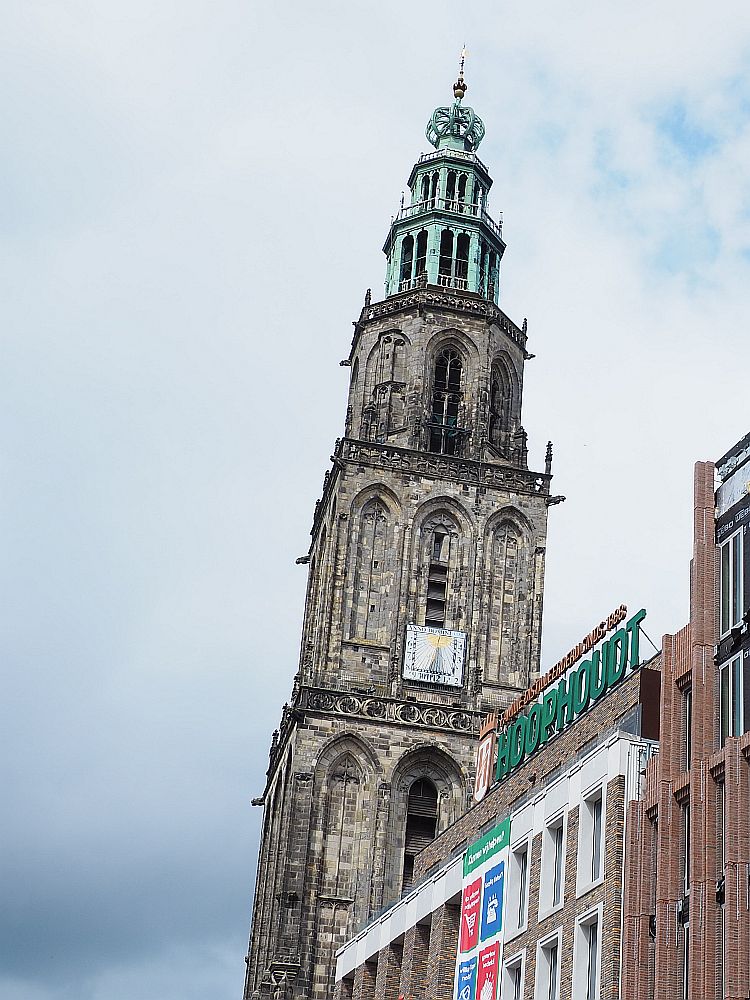
The other is on the same side of the square, but behind a row of buildings: you’ll see an oddly-shaped modern building peeking out. This structure is the Forum, completed in 2019. It may be new, but it’s become a destination in its own right.

At this point, you have two choices, or you can do both. One is to climb the ancient Martinitoren stairs to get a wider view of the small but complete city. It’s a narrow spiral staircase, and you’ll get a look at the inside of the domes of the church on the way up (and back down!) as well as the bells that still operate every 15 minutes from the tower.
Your other option is to ride the many escalators to the roof of the Forum. It’s much easier, and the interior of the pyramid-shaped building is quite stunning. The view is just as good, and you can see the Martinitoren while you enjoy a drink in the rooftop café. However, the roof is edged by tall glass walls, so your view will be through glass rather than unobstructed.
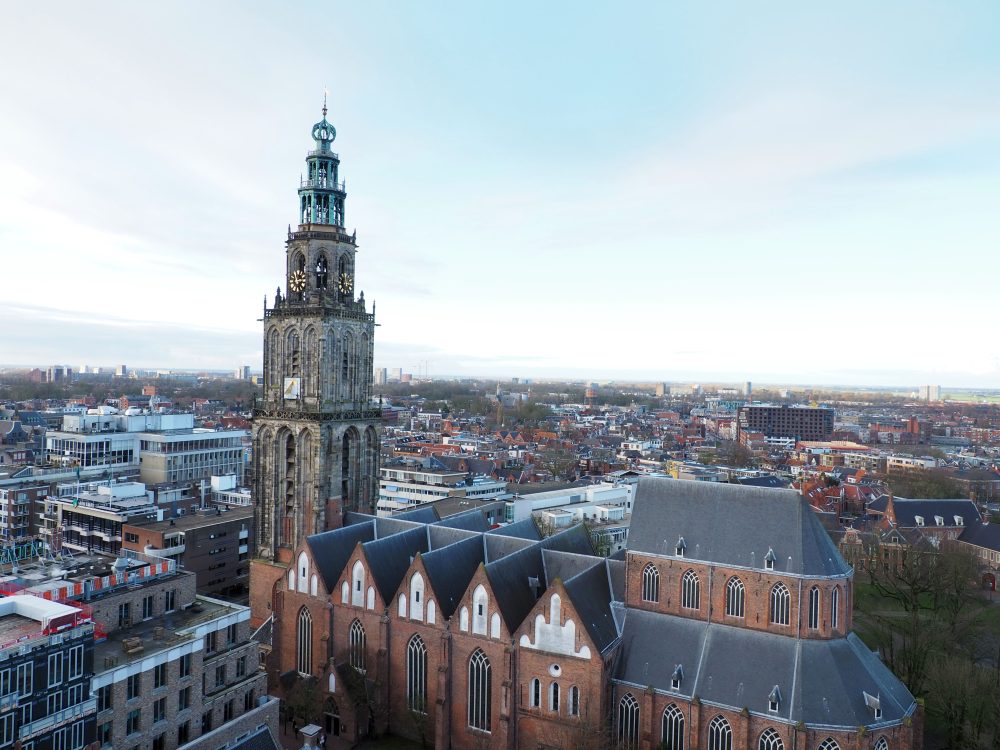
The Forum serves as an all-purpose building. It holds the library and Storyworld: a museum of comic strips and animation. It has a couple of cafés, an alternative movie theater, and lots of places for students to work. If you’re looking for specifically Groningen-related small gifts, go to the small store on the ground floor. You can get tourist information there too.
The Forum, by the way, is wheelchair accessible right to the roof. Ask someone at the information desk to direct you to the elevators you can use.
Nightlife after your Groningen walking tour
If nightlife is your thing, the place to go is the Poelestraat, which extends off the corner of the Grote Markt nearest to the Forum. There are lots of restaurants, pubs and clubs on this street, but if music and dancing is what you’re looking for, you’ll have to wait until quite late. Most of the clubs don’t even start up until past midnight.
While there’s more to see in Groningen, this tour will give you the highlights and help you form an impression. As the Groningers say: “There’s nothing above Groningen!”
(Last edited July 3, 2023)


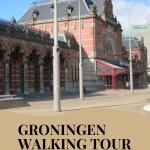
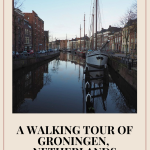

Bonjour Rachel
J écris en français car si je lis et comprends très bien l anglais, c’est plus difficile pour moi de l écrire.
Je me suis abonnée a ton blog après apres lu l article qu Albert a publié sur Facebook concernant la consommation des insectes….
J apprécie beaucoup tes publications et les lis toujours avec intérêt.
Je réagis sur celui sur Groningen,car comme tu le sais j y ai vécu quelques mois et j ai retrouvé avec plaisir l atmosphère chaleureuse que tu décris.
J adorais manger les stroopwafels tièdes avec le caramel bien tendre à l intérieur!!!!Miam!
Et la glace”boerenjongens”!
Bravo pour tes écrits et j espere que ton année sabbatique va bien se passer et que tu trouveras un éditeur
Amitiés
Christine
Merci, Christine! Sometimes I combine Dutch boerenjongens (a sort of alcohol-soaked raisin) with a classic American brownie: yum!
I adore walking tours. It’s amazing how many really unique things we will come across that we would never find if we were riding by. Thx for sharing this post about your hometown, Rachel.
You’re welcome! It’s hardly a tourist destination, but it’s such a pleasant city! And another small city about an hour from here, Leeuwarden, has a beautiful intact city center too.
I bet this is one that doesn’t pop up on the radar too often!
Thanks for some insights into a place I know of only thanks to football! 😉
My son and husband go to all of FC Groningen’s home games, but it doesn’t interest me. I’m surprised you’ve even heard of Groningen, but I bet you can’t pronounce it!
I’d really like to visit this city. Especially the Hooge der A. It looks so charming! Thanks for the insider’s look.
You should! Thanks for commenting!